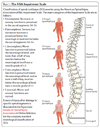Will stem cell therapies be safe and effective for treating spinal cord injuries?
- PMID: 21586446
- PMCID: PMC5583428
- DOI: 10.1093/bmb/ldr013
Will stem cell therapies be safe and effective for treating spinal cord injuries?
Abstract
Introduction: A large number of different cells including embryonic and adult stem cells have been transplanted into animal models of spinal cord injury, and in many cases these procedures have resulted in modest sensorimotor benefits. In October 2010 the world's first clinical trial using human embryonic stem cells began, using stem cells converted into oligodendrocyte precursor cells.
Sources of data: In this review we examine some of the publically available preclinical evidence that some of these cell types improve outcome in animal models of spinal cord injury. Much evidence is not available for public scrutiny, however, being private commercial property of various stem cell companies.
Areas of agreement: Transplantation of many different types of stem and progenitor cell enhances spontaneous recovery of function when transplanted acutely after spinal cord injury in animal models. AREAS OF DISAGREEMENT: The common mechanism(s) whereby the generic procedure of cellular transplantation enhances recovery of function are not well understood, although a range of possibilities are usually cited (including preservation of tissue, remyelination, axon sprouting, glial cell replacement). Only in exceptional cases has it been shown that functional recovery depends causally on the survival and differentiation of the transplanted cells. There is no agreement about the optimal cell type for transplantation: candidate stem cells have not yet been compared with each other or with other cell types (e.g. autologous Schwann cells) in a single study.
Areas timely for developing research: Transplantation of cells into animals with a long lifespan is important to determine whether or not tumours will eventually form. It will also be important to determine whether long-term survival of cells is required for functional recovery, and if so, how many are optimal.
Figures
Similar articles
-
Transplantation of human embryonic stem cell-derived oligodendrocyte progenitors into rat spinal cord injuries does not cause harm.Regen Med. 2006 Jul;1(4):469-79. doi: 10.2217/17460751.1.4.469. Regen Med. 2006. PMID: 17465839
-
Human Embryonic Stem Cell-Derived Oligodendrocyte Progenitor Cells: Preclinical Efficacy and Safety in Cervical Spinal Cord Injury.Stem Cells Transl Med. 2017 Oct;6(10):1917-1929. doi: 10.1002/sctm.17-0065. Epub 2017 Aug 22. Stem Cells Transl Med. 2017. PMID: 28834391 Free PMC article.
-
Human embryonic stem cell-derived oligodendrocyte progenitors aid in functional recovery of sensory pathways following contusive spinal cord injury.PLoS One. 2012;7(10):e47645. doi: 10.1371/journal.pone.0047645. Epub 2012 Oct 16. PLoS One. 2012. PMID: 23091637 Free PMC article.
-
Stem cell-based cell therapy for spinal cord injury.Cell Transplant. 2007;16(4):355-64. doi: 10.3727/000000007783464885. Cell Transplant. 2007. PMID: 17658126 Review.
-
What is the potential of oligodendrocyte progenitor cells to successfully treat human spinal cord injury?BMC Neurol. 2011 Sep 23;11:113. doi: 10.1186/1471-2377-11-113. BMC Neurol. 2011. PMID: 21943254 Free PMC article. Review.
Cited by
-
Does repair of spinal cord injury follow the evolutionary theory?Neural Regen Res. 2012 Apr 15;7(11):849-52. doi: 10.3969/j.issn.1673-5374.2012.11.009. Neural Regen Res. 2012. PMID: 25737713 Free PMC article. Review.
-
Pluripotent stem cells progressing to the clinic.Nat Rev Mol Cell Biol. 2016 Mar;17(3):194-200. doi: 10.1038/nrm.2016.10. Nat Rev Mol Cell Biol. 2016. PMID: 26908143 Review.
-
Development of embryonic stem cells in recombinant kidneys.Organogenesis. 2012 Oct-Dec;8(4):125-36. doi: 10.4161/org.22597. Epub 2012 Oct 1. Organogenesis. 2012. PMID: 23086378 Free PMC article.
-
Advances in regenerative therapies for spinal cord injury: a biomaterials approach.Neural Regen Res. 2015 May;10(5):726-42. doi: 10.4103/1673-5374.156966. Neural Regen Res. 2015. PMID: 26109946 Free PMC article. Review.
-
Electrical stimulation of embryonic neurons for 1 hour improves axon regeneration and the number of reinnervated muscles that function.J Neuropathol Exp Neurol. 2013 Jul;72(7):697-707. doi: 10.1097/NEN.0b013e318299d376. J Neuropathol Exp Neurol. 2013. PMID: 23771218 Free PMC article.
References
-
- Steeves JD, Fawcett JW, Tuszynski MH, Lammertse DP, Curt AEP, Ditunno JF, Ellaway PH, Fehlings MG, Guest JD, Kleitman N, Bartlett PF, et al. Experimental treatments for spinal cord injury: what you should know if you are considering participation in a clinical trial. 2007
-
- Thuret S, Moon LD, Gage FH. Therapeutic interventions after spinal cord injury. Nat Rev Neurosci. 2006;7:628–43. - PubMed
-
- Fawcett JW, Curt A, Steeves JD, Coleman WP, Tuszynski MH, Lammertse D, Bartlett PF, Blight AR, Dietz V, Ditunno J, Dobkin BH, et al. Guidelines for the conduct of clinical trials for spinal cord injury as developed by the ICCP panel: spontaneous recovery after spinal cord injury and statistical power needed for therapeutic clinical trials. Spinal Cord. 2007;45:190–205. - PubMed
-
- Crowe MJ, Bresnahan JC, Shuman SL, Masters JN, Beattie MS. Apoptosis and delayed degeneration after spinal cord injury in rats and monkeys. Nature Medicine. 1997;3:73–76. - PubMed
Publication types
MeSH terms
Grants and funding
LinkOut - more resources
Full Text Sources
Medical
Research Materials



